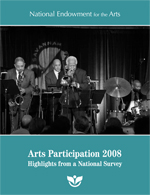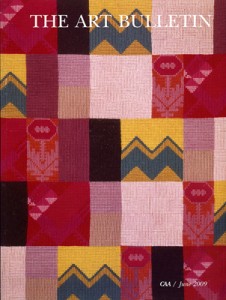CAA News Today
NEA Survey Shows a Decline in Art Participation
posted by Christopher Howard — June 16, 2009
 American audiences for the arts are getting older and their numbers are declining, according to new research released yesterday by the National Endowment for the Arts (NEA). Arts Participation 2008: Highlights from a National Survey, which can be ordered or downloaded from the NEA website, features top findings from the 2008 Survey of Public Participation in the Arts, the nation’s largest and most representative periodic study of adult participation in arts events and activities, conducted by the NEA in partnership with the US Census Bureau.
American audiences for the arts are getting older and their numbers are declining, according to new research released yesterday by the National Endowment for the Arts (NEA). Arts Participation 2008: Highlights from a National Survey, which can be ordered or downloaded from the NEA website, features top findings from the 2008 Survey of Public Participation in the Arts, the nation’s largest and most representative periodic study of adult participation in arts events and activities, conducted by the NEA in partnership with the US Census Bureau.
Five times since 1982, the survey has asked US adults eighteen and older about their patterns of arts participation over a twelve-month period. The 2008 survey reveals dwindling audiences for many art forms, but it also captures new data on internet use and other forms of arts participation. Although the 2008 recession likely affected survey responses, long-term trend analysis indicates that other factors also may have contributed to lower arts participation rates.
There are persistent patterns of decline in participation for most art forms. Although nearly 35 percent of US adults—an estimated 78 million—attended an art museum or an arts performance in the 2008 survey period, the figure is a decline from 40 percent reported in 1982, 1992, and 2002.
Attendance at the most popular types of arts events—such as art museums and craft or visual-arts festivals—saw notable declines. The US rate of attendance for art museums fell slightly from a high of 26 percent in 1992–2002 to 23 percent in 2008, comparable to the 1982 level.
Further, fewer adults are creating and performing art. Weaving and sewing remain popular as crafts, but the percentage of adults who do those activities has declined by 12 points. Only the number of adults doing photography has increased—from 12 percent in 1992 to 15 percent in 2008.
Historically the most dependable arts participants, forty-five to fifty-four-year-olds, showed the steepest declines in attendance for most art events, compared with other age groups. Educated Americans—the most likely to attend or participate in the arts—are doing so less than before, and less-educated adults have significantly reduced their already low levels of attendance.
In a positive trend, the internet and mass media are reaching substantial audiences for the arts. Consider these findings:
- About 70 percent of US adults went online for any purpose in 2008 survey, and of those adults, nearly 40 percent used the web to view, listen to, download, or post artworks or performances
- Thirty percent of internet-using adults download, watch, or listen to music, theater, or dance performances online at least once a week. More than 20 percent of them view paintings, sculpture, or photography at least once a week
- More Americans view or listen to broadcasts and recordings of arts events than attend them live (live theater being the sole exception). Classical and Latin or salsa music were the most popular music categories (with 40 and 33.5 million viewers/listeners, respectively), and 33.7 million adults reported listening to, or viewing programs or recordings about books and writers. The same number (33.7 million) enjoyed broadcasts or recordings about the visual arts.
The entire survey questionnaire, the raw data, and a user’s guide are available both on the NEA website and from Princeton University’s Cultural Policy and the Arts National Data Archive (CPANDA). More detailed study results will be available later this year.
CAA Statement on BHA and Getty Research Institute
posted by Michael Fahlund — June 12, 2009
Like many of our art colleagues and allied academic and cultural institutions in the field, the College Art Association is deeply concerned about the status of the Bibliography of the History of Art (BHA). CAA continues to communicate with the Getty Research Institute (copublisher of the BHA, along with the French Institut de l’Information Scientifique et Technique du Centre National de la Recherche Scientifique) about the future of the BHA and how this vital bibliographic resource can be maintained. We will do what we can as necessary to secure its longevity once we have had our inquiries answered by the Getty.
Obama Intends to Nominate Jim Leach as NEH Chairman
posted by Christopher Howard — June 04, 2009
Today, President Barack Obama announced his intent to nominate former Republican Congressman Jim Leach as Chairman of the National Endowment for the Humanities.
Obama said, “I am confident that with Jim as its head, the National Endowment for the Humanities will continue on its vital mission of supporting the humanities and giving the American public access to the rich resources of our culture. Jim is a valued and dedicated public servant and I look forward to working with him in the months and years ahead.”
Jim Leach served as a member of the US House of Representatives for the state of Iowa for thirty years. He founded and cochaired the Congressional Humanities Caucus, which is dedicated to advocating on behalf of the humanities in the House and to raising the profile of humanities in the United States. The caucus worked to promote and preserve humanities programs and commissions such as the Historical Publications and Records Commission. Leach and his cofounder, Rep. David Price, received the Sidney R. Yates Award for Distinguished Public Service to the Humanities from the National Humanities Alliance in 2005. During his tenure in Congress, Leach also served as chairman of the House Committee on Banking and Financial Services (1995-2001), a senior member of the House Committee on International Relations, and chairman of the committee’s Subcommittee on Asian and Pacific Affairs (2001-6). In addition, Leach is a member of the Council on Foreign Relations, the vice chairman of the Century Foundation’s board of trustees and has served on the boards of the Social Sciences Research Council, ProPublica, the Carnegie Endowment for International Peace and the Kettering Foundation. Since leaving Congress in 2007, he has taught at Princeton University and served as the interim director of the Institute of Politics at Harvard University’s John F. Kennedy School of Government.
Obama Intends to Nominate Jim Leach as NEH Chairman
posted by Christopher Howard — June 04, 2009
Today, President Barack Obama announced his intent to nominate former Republican Congressman Jim Leach as Chairman of the National Endowment for the Humanities.
Obama said, “I am confident that with Jim as its head, the National Endowment for the Humanities will continue on its vital mission of supporting the humanities and giving the American public access to the rich resources of our culture. Jim is a valued and dedicated public servant and I look forward to working with him in the months and years ahead.”
Jim Leach served as a member of the US House of Representatives for the state of Iowa for thirty years. He founded and cochaired the Congressional Humanities Caucus, which is dedicated to advocating on behalf of the humanities in the House and to raising the profile of humanities in the United States. The caucus worked to promote and preserve humanities programs and commissions such as the Historical Publications and Records Commission. Leach and his cofounder, Rep. David Price, received the Sidney R. Yates Award for Distinguished Public Service to the Humanities from the National Humanities Alliance in 2005. During his tenure in Congress, Leach also served as chairman of the House Committee on Banking and Financial Services (1995-2001), a senior member of the House Committee on International Relations, and chairman of the committee’s Subcommittee on Asian and Pacific Affairs (2001-6). In addition, Leach is a member of the Council on Foreign Relations, the vice chairman of the Century Foundation’s board of trustees and has served on the boards of the Social Sciences Research Council, ProPublica, the Carnegie Endowment for International Peace and the Kettering Foundation. Since leaving Congress in 2007, he has taught at Princeton University and served as the interim director of the Institute of Politics at Harvard University’s John F. Kennedy School of Government.
June 2009 Issue of The Art Bulletin Published
posted by Christopher Howard — June 02, 2009
 The June 2009 issue of The Art Bulletin, the leading publication of art-historical scholarship, has just been published. It will be mailed to those CAA members who elect to receive it, and to all institutional members.
The June 2009 issue of The Art Bulletin, the leading publication of art-historical scholarship, has just been published. It will be mailed to those CAA members who elect to receive it, and to all institutional members.
On the cover is a detail of a pillowcase designed ca. 1916 by the Swiss artist Sophie Taeuber, which accompanies an essay by Bibiana Obler that considers the difference between Taeuber’s and Hans Arp’s public and private identities through a set of collaborative and closely related works and why they kept their most “advanced” work to themselves.
For her contribution, Stephanie Leitch investigates Hans Burgkmair’s images of non-Western communities in the woodcut frieze The Peoples of Africa and India (1508), which neither played into iconographic presets nor invented new stereotypes. Two more essays round out the issue: Norma Broude explores the political dynamics of gender informing the intentions, subjects, production, and reception of Giambattista Tiepolo’s frescoes for the palazzina of the Villa Valmarana, and Laura Morowitz examines the extraordinary popularity and religious undercurrents of the Hungarian artist Mihály Munkácsy’s paintings Christ before Pilate and Christ on Golgotha in late-nineteenth-century America.
The June issue of The Art Bulletin also contains reviews of books on Chinese epigraphy, Giovanni Bellini, Lucas Cranach the Elder, and Marcel Duchamp. Please read the full table of contents for more details.


